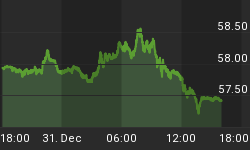First ... Happy New Year and don't forget that the market will be closed on Monday.
Now, on to today's Update:
Today, we will look at two Relative Strength settings that work well together. By the way, when you look our first chart, it says that the indicator is a C-RSI set for a 30 day time period. The C-RSI is not complex and itis something we invented to just make deciphering the chart easier.
C-RSI Explanation: Since the Relative Strength moves from 0 to 100, it is sometimes hard to discern if it is clearly positive or negative when looking at a chart. For the standard RSI indicator, it turns out that a reading of 50 is neutral, so everything above it should be interpreted as positive, and everything below it should be interpreted as negative. So, we decided to subtract a value of 50 from every RSI reading thereby making it zero based. That means that the old value of 50 now becomes 0, so it becomes visually clear if the RSI is really positive or negative.
With that explanation, let's move on to a chart showing what the C-RSI 30 has looked like on the NYA Index since last April. We won't get into C-RSI trends or divergences today, instead we will keep it simple.
First, notice the correlation between when the C-RSI is above the zero line or below it relative to the NYA's action. Following this one chart would have saved a lot of investors from losses in 2011.
Please see the next chart ...

Sometimes you are lucky enough to have something that will improve one of your charts. In this case, adding a C-RSI with a 9 day setting improves the value of the chart.
Take a look at the chart below ... it is the same as the one above, except we added a C-RSI 9 in red. A nine day C-RSI is faster than the 30 so it will lead the C-RSI 30. When the 9 C-RSI goes positive while the 30 C-RSI is negative but trending higher, then the NYA is normally right behind it. If the both turn positive at the same time, then the NYA's move can often be a sharper, quicker up move.
There is one more thing on this chart that can be very useful, and that is the use of Bollinger Bands ... which can be seen on the NYA Index.
When the NYA is above or below the Upper or Lower bands, the index or stock is normally overbought or oversold. When outside the Bollinger Bands, the key relative to what will happen next is typically related to what is happening to the 9 and 30 C-RSI levels. Take the time to learn and test this strategy, as it can do well for you in 2012.

















